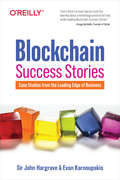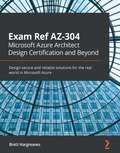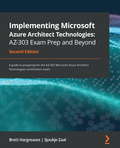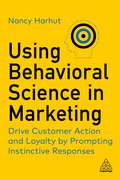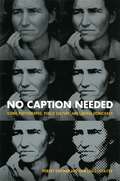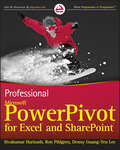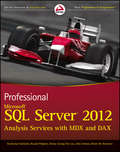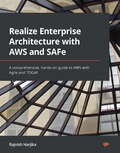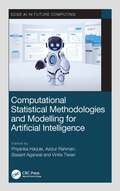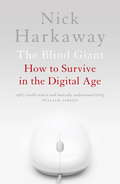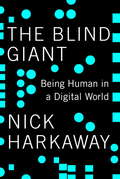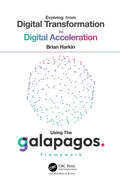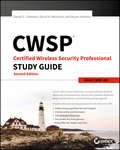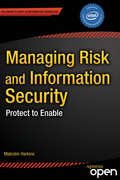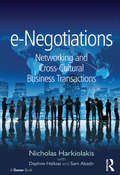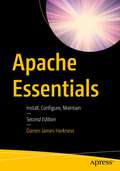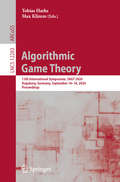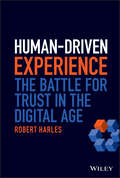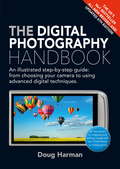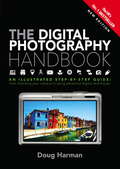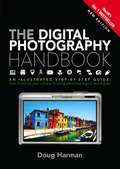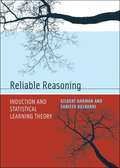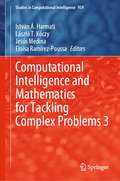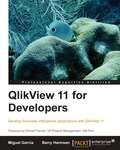- Table View
- List View
Blockchain Success Stories
by Sir John Hargrave Evan KarnoupakisAccessible and fun to read, this practical book contains a collection of stories of organizations using blockchain technology in practice. Through deep research and firsthand interviews, authors Sir John Hargrave and Evan Karnoupakis show you how leading-edge organizations have worked to integrate blockchain into their businesses.You'll start by exploring the origins of blockchain, with plain-English descriptions of industry terminology like bitcoin, cryptocurrencies, and smart contracts. Then you'll dive into 10 story-driven case studies that will teach you easy-to-understand blockchain best practices.Explore real-life examples of companies developing and integrating blockchain applications for mobile voting, credentialing, supply chains, and a $100 million virtual cat collectible marketplaceDiscover how blockchain is transforming industries like banking, communications, government, logistics, and nonprofitsLearn about engaging blockchain success stories, such as Binance, Ethereum, and CircleExamine common blockchain best practices, with illustrations for easy reference, and learn how to apply them in your business, government project, or charitable foundation
Exam Ref AZ-304 Microsoft Azure Architect Design Certification and Beyond: Design secure and reliable solutions for the real world in Microsoft Azure
by Brett HargreavesMaster the Microsoft Azure platform and prepare for the AZ-304 certification exam by learning the key concepts needed to identify key stakeholder requirements and translate these into robust solutionsKey FeaturesBuild secure and scalable solutions on the Microsoft Azure platformLearn how to design solutions that are compliant with customer requirementsWork with real-world scenarios to become a successful Azure architect, and prepare for the AZ-304 examBook DescriptionThe AZ-304 exam tests an architect's ability to design scalable, reliable, and secure solutions in Azure based on customer requirements. Exam Ref AZ-304 Microsoft Azure Architect Design Certification and Beyond offers complete, up-to-date coverage of the AZ-304 exam content to help you prepare for it confidently, pass the exam first time, and get ready for real-world challenges. This book will help you to investigate the need for good architectural practices and discover how they address common concerns for cloud-based solutions. You will work through the CloudStack, from identity and access through to infrastructure (IaaS), data, applications, and serverless (PaaS). As you make progress, you will delve into operations including monitoring, resilience, scalability, and disaster recovery. Finally, you'll gain a clear understanding of how these operations fit into the real world with the help of full scenario-based examples throughout the book. By the end of this Azure book, you'll have covered everything you need to pass the AZ-304 certification exam and have a handy desktop reference guide.What you will learnUnderstand the role of architecture in the cloudEnsure security through identity, authorization, and governanceFind out how to use infrastructure components such as compute, containerization, networking, and storage accountsDesign scalable applications and databases using web apps, functions, messaging, SQL, and Cosmos DBMaintain operational health through monitoring, alerting, and backupsDiscover how to create repeatable and reliable automated deploymentsUnderstand customer requirements and respond to their changing needsWho this book is forThis book is for Azure Solution Architects who advise stakeholders and help translate business requirements into secure, scalable, and reliable solutions. Junior architects looking to advance their skills in the Cloud will also benefit from this book. Experience with the Azure platform is expected, and a general understanding of development patterns will be advantageous.
Implementing Microsoft Azure Architect Technologies: AZ-303 Exam Prep and Beyond
by Brett HargreavesThis book is for solution architects and experienced developers who advise stakeholders and translate business requirements into secure, scalable, and reliable solutions. Technical architects interested in learning more about designing cloud solutions will also find this book useful. Prior experience and knowledge of various aspects of IT operations, including networking, security, business continuity, disaster recovery, budgeting, and governance, will assist with understanding the concepts covered in the book.
Using Behavioral Science in Marketing: Drive Customer Action and Loyalty by Prompting Instinctive Responses
by Nancy HarhutIncrease engagement, response rates and the ROI of marketing initiatives with this step-by-step guide to harnessing hardwired consumer behavior and instinctive responses. Using Behavioral Science in Marketing shows how to apply behavioral science principles in key areas of marketing, including marketing communications, email, direct mail and ad campaigns, social media marketing and sales funnel conversion strategies. Highly practical and accessible, it includes case studies and examples from AT&T, Apple, Spotify and The Wall Street Journal showing how these approaches have been used in practice. Using Behavioral Science in Marketing also reveals how to increase consumer involvement and engagement, convey exclusivity and desirability, and prompt customer action and loyalty with scientifically proven principles such as autonomy bias, storytelling, and the Von Restorff effect. Featuring common mistakes to avoid and key takeaways at the end of each chapter, it's also accompanied by downloadable checklists and an interactive template to use in practice. In a highly competitive space, where even an incremental advantage can result in significant uplifts, this is a crucial resource to create stand out and successful marketing-especially for marketers in highly regulated or highly competitive environments.
No Caption Needed: Iconic Photographs, Public Culture, and Liberal Democracy
by Robert Hariman John Louis LucaitesThe gaunt woman, her face lined with care, stares past the camera while three children cling to her amidst the Great Depression. A soldier catches a nurse in a powerful embrace on VJ Day in Times Square as onlookers smile approvingly. A naked Vietnamese girl runs in terror from the napalm attack engulfing the road behind her. Plumes of smoke streak outward in silent array as the Challenger explodes in the blue air over Florida. A solitary Chinese man stands calmly before the barrel of a tank at Tiananmen Square.
Professional Microsoft PowerPivot for Excel and SharePoint
by Sivakumar Harinath Ron Pihlgren Denny Guang-Yeu LeeThe next wave of business intelligence, Self-Service BI, seeks to meet the demands of powerful hardware and shorter decision time frames. This book introduces PowerPivot for Excel and SharePoint, showing you how to use this innovative software for self-service analytics and reporting. Authored by key members of the Microsoft team that built the product, this book will guide you through the use of in-memory BI server technology, data analytics eXpressions, and report gallery. The book also discusses how to deploy and manage sandbox servers, and a companion website provides sample reports and applications.
Professional Microsoft SQL Server 2012 Analysis Services with MDX and DAX
by Sivakumar Harinath John Sirmon Denny Guang-Yeu Lee Robert M. Bruckner Ronald PihlgrenUnderstand Microsoft's dramatically updated new release of its premier toolset for business intelligenceThe first major update to Microsoft's state-of-the-art, complex toolset for business intelligence (BI) in years is now available and what better way to master it than with this detailed book from key members of the product's development team? If you're a database or data warehouse developer, this is the expert resource you need to build full-scale, multi-dimensional, database applications using Microsoft's new SQL Server 2012 Analysis Services and related tools.Discover how to solve real-world BI problems by leveraging a slew of powerful new Analysis Services features and capabilities. These include the new DAX language, which is a more user-friendly version of MDX; PowerPivot, a new tool for performing simplified analysis of data; BISM, Microsoft's new Business Intelligence Semantic Model; and much more.Serves as an authoritative guide to Microsoft's new SQL Server 2012 Analysis Services BI product and is written by key members of the Microsoft Analysis Services product development team Covers SQL Server 2012 Analysis Services, a major new release with a host of powerful new features and capabilities Topics include using the new DAX language, a simplified, more user-friendly version of MDX; PowerPivot, a new tool for performing simplified analysis of data; BISM, Microsoft's new Business Intelligence Semantic Model; and a new, yet-to-be-named BI reporting tool Explores real-world scenarios to help developers build comprehensive solutions Get thoroughly up to speed on this powerful new BI toolset with the timely and authoritative Professional Microsoft SQL Server 2012 Analysis Services with MDX.
Realize Enterprise Architecture with AWS and SAFe: A comprehensive, hands-on guide to AWS with Agile and TOGAF
by Rajnish HarjikaHarness the power of enterprise architecture, AWS, and agile methodologies to optimize operational efficiency in your organizationKey FeaturesUse EA and agile practices to maximize your organization's operational efficiencyLearn how to use EA approaches in AWS through their prescriptive frameworksAlign SAFe principles with EA and cloud migrationBook DescriptionAgile implementation of enterprise architecture (EA) in the cloud is a powerful organizational tool, but it is challenging, particularly for architects who are used to on-premises environments. This in-depth guide will tell you all you need to know to reap the benefits of applying EA in your organization to achieve operational efficiency.Starting with an overview of the foundations of enterprise architecture, you'll see how it can be applied to AWS as well as explore the frameworks AWS provides for EA, such as the AWS Well-Architected Framework. That's not all – the book shows you how these frameworks align with The Open Group Architecture Framework (TOGAF) architecture development method (ADM) and the Zachman Framework so that you can choose the right fit for your organization. As you advance, you'll learn how to apply SAFe to make your organization agile as well as efficient. Once you've gotten to grips with the theory, you can explore use cases and take a quiz at the end of the book to test yourself and see how EA is applied in practice.By the end of this enterprise architecture book, you'll have the skills and knowledge required to apply EA in the cloud with AWS and drive your organization to become super-efficient and agile.What you will learnSet up the core foundation of your enterprise architectureDiscover how TOGAF relates to enterprise architectureExplore AWS's EA frameworks and find out which one is the best for youUse SAFe to maximize agility in your organizationFind out how to use ArchiMate to model your architectureEstablish proper EA practices in your organizationMigrate to the cloud with AWS and SAFeWho this book is forThis agility book is for experienced and inexperienced solutions architects, enterprise architects, and cloud architects who know the basics of software and solutions architecture, along with cloud fundamentals, and are looking to get started with AWS and SAFe to implement enterprise architecture in the cloud.
Computational Statistical Methodologies and Modeling for Artificial Intelligence (ISSN)
by Priyanka Harjule Azizur Rahman Basant Agarwal Vinita TiwariThis book covers computational statistics-based approaches for Artificial Intelligence. The aim of this book is to provide comprehensive coverage of the fundamentals through the applications of the different kinds of mathematical modelling and statistical techniques and describing their applications in different Artificial Intelligence systems. The primary users of this book will include researchers, academicians, postgraduate students, and specialists in the areas of data science, mathematical modelling, and Artificial Intelligence. It will also serve as a valuable resource for many others in the fields of electrical, computer, and optical engineering.The key features of this book are: Presents development of several real-world problem applications and experimental research in the field of computational statistics and mathematical modelling for Artificial Intelligence Examines the evolution of fundamental research into industrialized research and the transformation of applied investigation into real-time applications Examines the applications involving analytical and statistical solutions, and provides foundational and advanced concepts for beginners and industry professionals Provides a dynamic perspective to the concept of computational statistics for analysis of data and applications in intelligent systems with an objective of ensuring sustainability issues for ease of different stakeholders in various fields Integrates recent methodologies and challenges by employing mathematical modeling and statistical techniques for Artificial Intelligence
The Blind Giant: How to Survive in the Digital Age
by Nick HarkawayThe digital age. An age of isolation, warped communication, disintegrating community. Where unfiltered and unregulated information pours relentlessly into our lives, destroying what it means to be human. Or an age of marvels. Where there is a world of wonder at our fingertips. Where we can communicate across the globe, learn in the blink of an eye, pull down the barriers that divide us and move forward together. Whatever your reaction to technological culture, the speed with which our world is changing is both mesmerising and challenging. In The Blind Giant, novelist and tech blogger Nick Harkaway draws together fascinating and disparate ideas to challenge the notion that digital culture is the source of all our modern ills, while at the same time showing where the dangers are real and suggesting how they can be combated. Ultimately, the choice is ours: engage with the machines that we have created, or risk creating a world which is designed for corporations and computers rather than people. This is an essential handbook for everyone trying to be human in a digital age.
The Blind Giant: How to Survive in the Digital Age
by Nick HarkawayThe digital age. An age of isolation, warped communication, disintegrating community. Where unfiltered and unregulated information pours relentlessly into our lives, destroying what it means to be human. Or an age of marvels. Where there is a world of wonder at our fingertips. Where we can communicate across the globe, learn in the blink of an eye, pull down the barriers that divide us and move forward together. Whatever your reaction to technological culture, the speed with which our world is changing is both mesmerising and challenging. In The Blind Giant, novelist and tech blogger Nick Harkaway draws together fascinating and disparate ideas to challenge the notion that digital culture is the source of all our modern ills, while at the same time showing where the dangers are real and suggesting how they can be combated. Ultimately, the choice is ours: engage with the machines that we have created, or risk creating a world which is designed for corporations and computers rather than people. This is an essential handbook for everyone trying to be human in a digital age.
The Blind Giant
by Nick HarkawayNick Harkaway, author of Angelmaker, presents a rousing and energizing look at how we can meaningfully and constructively engage with technology--creating an essential handbook for anyone trying to be human in a digital age. Some say our devices will lead us to ruin: isolating us from our neighbors, warping communication, delivering an unregulated flood of information that will destroy our humanity. Some say they will be our salvation: enabling global communication and social engagement, putting all the world's facts at our fingertips, and erasing the barriers that divide us, bringing out the best qualities of humanity. In The Blind Giant, novelist and blogger Nick Harkaway takes us on a lucid, insightful and personal tour of how we live our lives in our technology-obsessed culture. A self-described "missing link" between the pre-Internet generation and the "digital natives" who have grown up with technology, Nick is an enthusiastic guide to digital culture who weaves together examples from literature, psychology, neurology, sociology, history, and his own life while exploring the hazards and joys of the human-machine relationship. In the final analysis, whether we meaningfully engage with the machines we have created, or risk living in a world which is designed to serve computers and corporations rather than people, this book is a must-read for anyone concerned with our digital future.
Evolving from Digital Transformation to Digital Acceleration Using The Galapagos Framework
by Brian HarkinEvolving from Digital Transformation to Digital Acceleration Using The Galapagos Framework challenges established thinking and offers a new way to deliver digital change. It introduces The Galapagos Framework, which is a new, innovative, and human-centric approach to transformational change. The framework allows organizations to move from digital transformation to digital acceleration, resulting in the creation of exciting and groundbreaking products as well as having a positive impact on the motivation and well-being of their teams.Digital Acceleration is an iterative process that allows organizations to deliver transformations and demonstrate continual progress at pace. Rather than tackling the transformation as one large single event, Digital Acceleration enables organizations to improve one or, at most, two discrete areas of the business quickly and then move onto the next area needing improvement.Presenting a detailed guide to The Galapagos Framework, the book also highlights solutions to common issues, expert case studies, and The Galapagos Roadmap. It discusses how the framework provides the key to increasing productivity, delivery velocity, and performance while reducing cost and complexity, ultimately resulting in digital and business success. The book demonstrates how The Galapagos Framework operates in practice to provide clear solutions to common issues that are classifi ed into Human Elements, Organizational Factors, and the Delivery Aspects. The book also explains why the current approaches to digital transformation are failing and shows how digital leaders and organizations can: Increase productivity Reduce costs Improve delivery performance Reduce operational, financial, and delivery risks Increase profits Deliver digital transformation success
CWSP: Exam CWSP-205
by Bryan E. Harkins David D. Coleman David A. WestcottThe most detailed, comprehensive coverage of CWSP-205 exam objectives CWSP: Certified Wireless Security Professional Study Guide offers comprehensive preparation for the CWSP-205 exam. Fully updated to align with the new 2015 exam, this guide covers all exam objectives and gives you access to the Sybex interactive online learning system so you can go into the test fully confident in your skills. Coverage includes WLAN discovery, intrusion and attack, 802.11 protocol analysis, wireless intrusion prevention system implementation, Layer 2 and 3 VPN over 802.11 networks, managed endpoint security systems, and more. Content new to this edition features discussions about BYOD and guest access, as well as detailed and insightful guidance on troubleshooting. With more than double the coverage of the "official" exam guide, plus access to interactive learning tools, this book is your ultimate solution for CWSP-205 exam prep. The CWSP is the leading vendor-neutral security certification administered for IT professionals, developed for those working with and securing wireless networks. As an advanced certification, the CWSP requires rigorous preparation -- and this book provides more coverage and expert insight than any other source. Learn the ins and outs of advanced network security Study 100 percent of CWSP-205 objectives Test your understanding with two complete practice exams Gauge your level of preparedness with a pre-test assessment The CWSP is a springboard for more advanced certifications, and the premier qualification employers look for in the field. If you've already earned the CWTS and the CWNA, it's time to take your career to the next level. CWSP: Certified Wireless Security Professional Study Guide is your ideal companion for effective, efficient CWSP-205 preparation.
Managing Risk and Information Security: Protect to Enable
by Malcolm HarkinsManaging Risk and Information Security: Protect to Enable, an ApressOpen title, describes the changing risk environment and why a fresh approach to information security is needed. Because almost every aspect of an enterprise is now dependent on technology, the focus of IT security must shift from locking down assets to enabling the business while managing and surviving risk. The book discusses business risk from a broader perspective, including privacy and regulatory considerations. It describes the increasing number of threats and vulnerabilities, but also offers strategies for developing solutions. These include discussions of how enterprises can take advantage of new and emerging technologiessuch as social media and the huge proliferation of Internet-enabled deviceswhile minimizing risk. With ApressOpen content will be freely available through multiple online distribution channels and electronic formats with the goal of disseminating professionally edited and technically reviewed content to the worldwide community. Here are some of the responses from reviewers of this exceptional work: Managing Risk and Information Security is a perceptive, balanced, and often thought-provoking exploration of evolving information risk and security challenges within a business context. Harkins clearly connects the needed, but often-overlooked linkage and dialog between the business and technical worlds and offers actionable strategies. The book contains eye-opening security insights that are easily understood, even by the curious layman. Fred Wettling, Bechtel Fellow, IS&T Ethics & Compliance Officer, Bechtel As disruptive technology innovations and escalating cyber threats continue to create enormous information security challenges, Managing Risk and Information Security: Protect to Enable provides a much-needed perspective. This book compels information security professionals to think differently about concepts of risk management in order to be more effective. The specific and practical guidance offers a fast-track formula for developing information security strategies which are lock-step with business priorities. Laura Robinson, Principal, Robinson Insight Chair, Security for Business Innovation Council (SBIC) Program Director, Executive Security Action Forum (ESAF) The mandate of the information security function is being completely rewritten. Unfortunately most heads of security haven't picked up on the change, impeding their companies' agility and ability to innovate. This book makes the case for why security needs to change, and shows how to get started. It will be regarded as marking the turning point in information security for years to come. Dr. Jeremy Bergsman, Practice Manager, CEB The world we are responsible to protect is changing dramatically and at an accelerating pace. Technology is pervasive in virtually every aspect of our lives. Clouds, virtualization and mobile are redefining computing and they are just the beginning of what is to come. Your security perimeter is defined by wherever your information and people happen to be. We are attacked by professional adversaries who are better funded than we will ever be. We in the information security profession must change as dramatically as the environment we protect. We need new skills and new strategies to do our jobs effectively. We literally need to change the way we think. Written by one of the best in the business, Managing Risk and Information Security challenges traditional security theory with clear examples of the need for change. It also provides expert advice on how to dramatically increase the success of your security strategy and methods from dealing with the misperception of risk to how to become a Z-shaped CISO. Managing Risk and Information Security is the ultimate treatise on how to deliver effective security to the world we live in for the next 10 years. It is absolute must reading for anyone in our profession and should be on the desk of every CISO in the worl
e-Negotiations: Networking and Cross-Cultural Business Transactions
by Nicholas Harkiolakis Daphne HalkiasPractical negotiating skills, including those needed for cross-cultural negotiations have long been taught in classrooms, along with some of the theory that underpins them. Most of this has been based on the notion that negotiation will be interpersonal and face-to-face. In recent years, though, globalization, the telecommunications boom and the ever increasing need for today's professionals to conduct cross-cultural business transactions has led to a new way of negotiating, bargaining, and resolving disputes. In e-Negotiations, Nicholas Harkiolakis and his co-authors highlight the challenge that awaits the young professionals who are today training in business schools. Future dispute resolutions and bargaining will take place between faceless disputants involved in a new kind of social process. Any adolescent with a mobile phone and Internet access knows that most of today's social transactions take place via a hand held or other electronic device. In a world of video conferences, chat rooms, Skype, Facebook, and MySpace, critical financial, business and political decisions are made through interaction between two-dimensional characters on screens. Here, the authors compare and contrast e-negotiation as it currently is with traditional face-to-face negotiation. Case studies illustrate how cross-cultural negotiations can be managed through modern channels of social influence and information-sharing and shed light on the critical social, cognitive and behavioral role of the negotiator in resolving on-line, cross-cultural, conflicts and disputes, and generally in bargaining and negotiation. This book, with its practical exercises, will be of immense help to students and professionals needing to 'practice' with the new negotiating media.
Apache Essentials: Install, Configure, Maintain
by Darren James Harkness* Covers the most up-to-date versions of the technology. * Teaches subject using real world tutorials. * Subject is taught in a very concise, no-nonsense fashion, wasting little time on history and other fluff. Book is therefore compact and portable. It gives you just what you need. * Demystifies what is sometimes thought of as an intimidating subject. * Covers Apache for Windows, Mac/Unix, and Linux. * Full book support available online and via e-mail.
Algorithmic Game Theory: 13th International Symposium, SAGT 2020, Augsburg, Germany, September 16–18, 2020, Proceedings (Lecture Notes in Computer Science #12283)
by Tobias Harks Max KlimmThis book constitutes the refereed proceedings of the 13th International Symposium on Algorithmic Game Theory, SAGT 2020, held in Augsburg, Germany, in September 2020.* The 21 full papers presented together with 3 abstract papers were carefully reviewed and selected from 53 submissions. The papers are organized in topical sections named: auctions and mechanism design, congestion games and flows over time, markets and matchings, scheduling and games on graphs, and social choice and cooperative games. * The conference was held virtually due to the COVID-19 pandemic.
Human-Driven Experience: The Battle for Trust in the Digital Age
by Robert HarlesExplore the human side of the latest digital technologies and trends In Human-Driven Experience: The Battle for Trust in a Digital Age, veteran digital strategist delivers a must-read exploration of how to capture the attention of consumers whose tolerance for inauthenticity is at an all-time low. In the book, you&’ll discover ways to harness the sometimes whiplash-inducing pace of change in the marketplace to accelerate innovation in your own organisation. The author discusses the need for increased mobility between functional areas like information technology, digital and marketing and how privacy and security must become essential components of your brand's promise to consumers. You'll also find: Strategies for creating end-to-end digital experiences that hit home with consumers Techniques for rising above the ever-loudening din of inauthentic advertising and marketing that has made consumers increasingly sceptical of new and established brands Incisive discussions of how data is becoming ever more targeted, identifiable and real-time – and what to do about it Perfect for executives, managers and other business leaders, Human-Driven Experience is also a can't-miss resource for marketing, digital and IT professionals looking for ways to make sense of a consumer landscape that's been turned upside down by digital technologies.
The Digital Photography Handbook: An Illustrated Step-by-step Guide
by Doug HarmanNeed to know which digital camera to buy? Want to take better photographs and retouch images? Ready to achieve professional results? This updated edition of The Digital Photography Handbook will allow you to make the most of all the advantages your camera has to offer - as well as guiding you through the latest software to enhance your images, and get professional results with every shot. This book includes expert advice on the art of photography (composition, depth of field and how to photograph a variety of subjects), editing and image manipulation software, how to print your images for the best results, developing a portfolio and mastering the rules of copyright. Doug Harman includes the very latest developments in digital technology, equipping you with everything you need to become a photographer. Contents include: Types of camera, Computers and software, Memory, Pixels and magnification, Saving images, Exposure, Composition, Light, Camera modes, Special effects, Manipulating images, Photo apps, Retouching old photos, Printing digital images, Selecting printers and paper, Archiving and the cloud, Making money from your images, Copyright rules and more.
The Digital Photography Handbook: An Illustrated Step-by-step Guide
by Doug HarmanNeed to know which digital camera to buy? Want to take better photographs and retouch images? Ready to achieve professional results? This updated edition of The Digital Photography Handbook will allow you to make the most of all the advantages your camera has to offer - as well as guiding you through the latest software to enhance your images, and get professional results with every shot. This book includes expert advice on the art of photography (composition, depth of field and how to photograph a variety of subjects), editing and image manipulation software, how to print your images for the best results, developing a portfolio and mastering the rules of copyright. Doug Harman includes the very latest developments in digital technology, equipping you with everything you need to become a photographer. Contents include: Types of camera, Computers and software, Memory, Pixels and magnification, Saving images, Exposure, Composition, Light, Camera modes, Special effects, Manipulating images, Photo apps, Retouching old photos, Printing digital images, Selecting printers and paper, Archiving and the cloud, Making money from your images, Copyright rules and more.
Digital Photography Handbook
by Doug Harman David JonesIn the last few years digital cameras and "digital darkrooms" in the form of computers and image manipulation software have revolutionized modern photography. Truly professional results are tantalizingly within reach of all--and The Digital Photography Handbook shows you how to combine photographic flair with digital expertise to achieve them. Part one looks at the cameras, the lenses and other hardware accessories, explains the technology behind them and helps you choose exactly what you need. Part two explores the art of photography itself, from composing a shot to considerations such as depth of field, focus or exposure. It also examines a series of themes such as landscapes, weddings and holidays providing tips and ideas for how to photograph them. Part three moves into the "digital darkroom". Here, expert instruction will give you the confidence to correct common problems and get the most out of your images, while a series of masterclasses focuses on professional image manipulation techniques and artistic effects, breaking them down into step-by-step stages for you to follow. Finally, part four looks at printing your photographs--whether to paper or on to the web. For those interested in taking their photography a little further, it explores building a portfolio and offers advice on copyright and selling your pictures.In this new, updated edition Doug Harrman includes the very latest developments in digital technology, equipping you with everything you need to become an accomplished 21st-century photographer.
Reliable Reasoning: Induction and Statistical Learning Theory
by Gilbert Harman Sanjeev KulkarniIn Reliable Reasoning, Gilbert Harman and Sanjeev Kulkarni, a philosopher and an engineer, argue that philosophy and cognitive science can benefit from statistical learning theory (SLT), the theory that lies behind recent advances in machine learning.
Computational Intelligence and Mathematics for Tackling Complex Problems 3 (Studies in Computational Intelligence #959)
by István Á. Harmati László T. Kóczy Jesús Medina Eloísa Ramírez-PoussaComplex problems and systems, which prevail in the real world, cannot often be tackled and solved either by traditional methods offered by mathematics or even the traditional computer science (CS) and and artificial intelligence (AI)..). What is the way out of this dilemma? Advanced methodologies, and tools and techniques, „mimicking” human reasoning or the behavior of animals, animal populations or certain parts of the living bod, based on traditional computer science science and the initial approaches of artificial intelligence are often referred to as biologically inspired methods, or often computational intelligence (CI). Computational intelligence offers effective and efficient solutions to many „unsolvable" problems problems. However, it is far from being a ready to use and complete collection of approaches, and is rather a continuously developing field without clear borders. The emerging new models and algorithms of computational intelligence are deeply rooted in the vast apparatus of traditional mathematics. Thus, the investigation of connections and synergy between mathematics and computational intelligence is an eminent goal which is periodically pursued by a group of mathematicians and computational intelligence researchers who regularly attand the annual European Symposia on Computational Intelligence and Mathematics (ESCIM). Some relevant papers from the last ESCIM-2020 are included in this volume.
QlikView 11 for Developers
by Barry Harmsen Miguel GarciaIt will be a step-by-step tutorial that will discuss best practices. The book is structured in such a way that it can be read both from start to end or can be dipped into. If you are a developer who is looking to learn a fast and easy way to learn to develop your business intelligence apps with QlikView, then this book is for you. If you are a power-user in a QlikView environment, then you will find quicker ways of working with QlikView. You should know the basics of business intelligence before you pick up this book. This book covers QlikView Desktop Personal Edition. Deployments to QlikView Server/Publisher are out of scope for this book.
